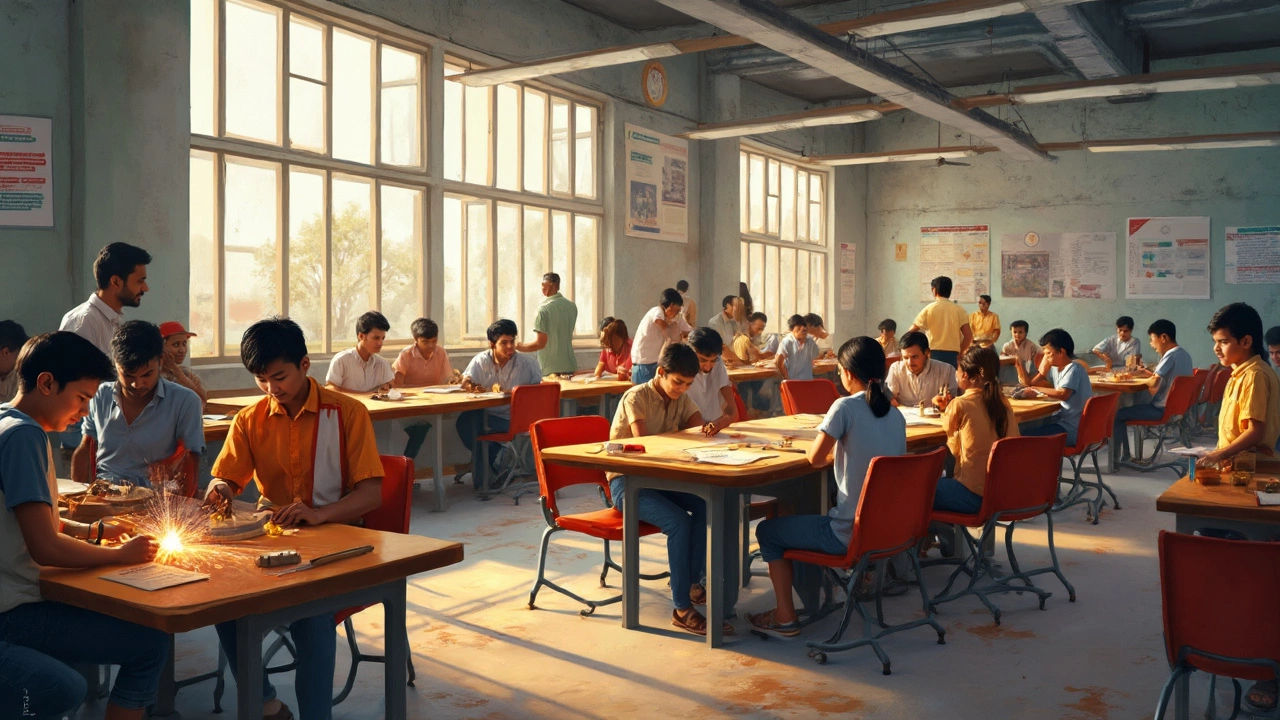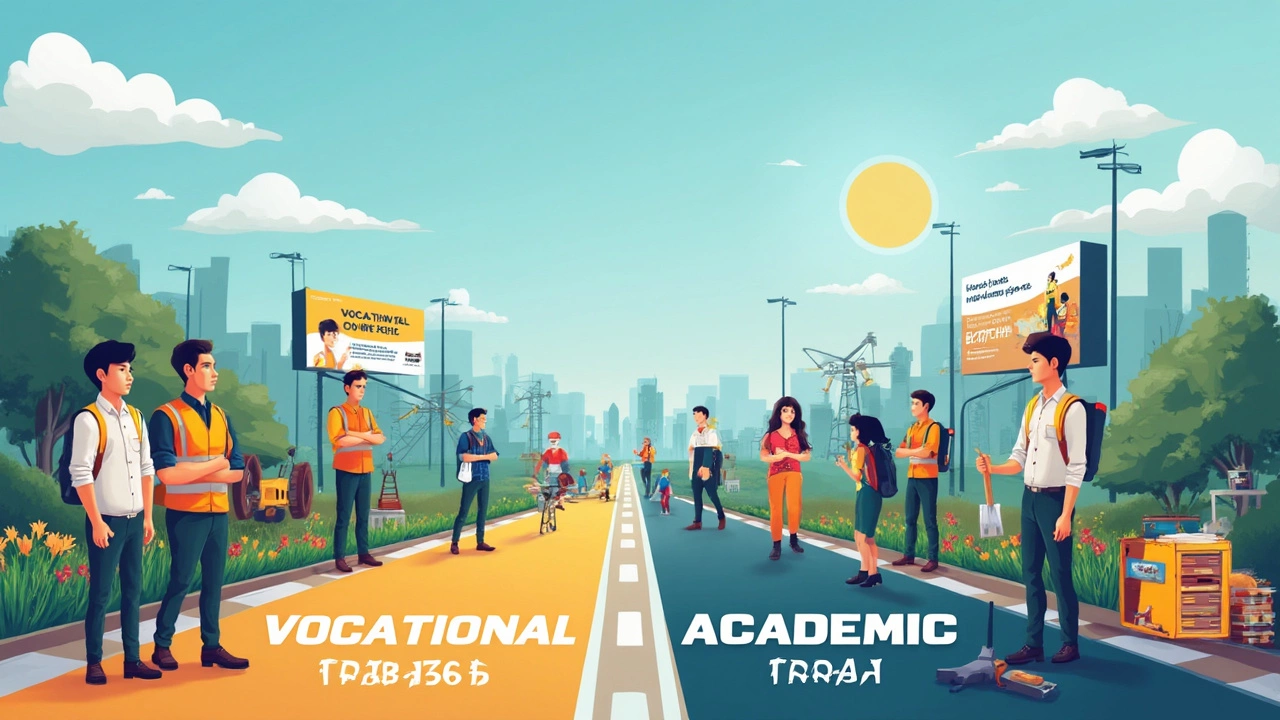
You might’ve heard the term ‘vocational career path’ tossed around, but what does it really mean? Forget the old idea that only classroom education can set you up for success. A vocational path is all about learning the practical skills you need to land a job in fields like plumbing, healthcare, mechanics, or even computer support—basically, roles where you do real work, not just theory.
In India, government vocational training has put a spotlight on jobs that are always in demand, but often overlooked. While everyone knows someone slogging through college lectures, vocational students spend more time practicing their craft. Imagine learning how to fix trucks, run a diagnostic machine, prepare meals in a commercial kitchen, or install solar panels—these jobs don’t just stay on paper, they’re out there for the taking.
If you’re weighing your options or thinking about skipping the endless exam grind for something faster and more hands-on, understanding this path could change how you see your future. We’ll break down who it’s for, why it’s different from regular academics, and give you some tips for picking the right training for your goals.
- Vocational Career Path Explained
- How Government Vocational Training Works
- Benefits Over Traditional Academics
- Who Should Consider Vocational Training?
- Tips for Choosing Your Path
Vocational Career Path Explained
A vocational career path is a direct route into skilled work, usually based on specific trades or technical fields. Unlike a traditional college degree, this path focuses on learning by doing. You spend most of your training in workshops, labs, or on real job sites. That means by the time you finish, you're ready to work straight away.
Think about careers like electricians, welders, auto mechanics, or even hospitality managers. These aren’t jobs you learn from a textbook alone. You need hands-on training and real practice, which is exactly what vocational programs offer.
In India, the government backs hundreds of these training centers under schemes like Skill India and Pradhan Mantri Kaushal Vikas Yojana (PMKVY). Every year, millions sign up to get certified in skills that help them find work quickly. According to the Ministry of Skill Development and Entrepreneurship, over 1 crore youngsters have been trained under PMKVY till 2023, and most programs last from a few months to two years—much faster than a typical college degree.
| Training Type | Typical Duration | Main Focus |
|---|---|---|
| College Degree | 3-5 years | Theory and broad subjects |
| Vocational Course | 3 months - 2 years | Practical job-ready skills |
What sets the vocational career path apart is the speed. You can enter the workforce fast, often with far less debt. For many families, especially those like mine with kids weighing options after 12th, this is a huge plus.
Some folks still think these jobs are ‘lesser’ than office jobs or engineering degrees, but here’s the thing: skilled trades are always in demand and can offer great pay over time. Plenty of mechanics or technicians earn more than junior engineers fresh out of college. Plus, as businesses race to find people who can actually do the work (not just pass exams), vocational careers keep getting more respect—and better opportunities.
How Government Vocational Training Works
So, how does government vocational training actually run behind the scenes? Across India—and honestly, in most countries—these programs are designed to teach specific job skills with the support and funding of the government. The aim is to get people job-ready without drowning them in years of textbooks.
The Ministry of Skill Development and Entrepreneurship runs big schemes like PMKVY (Pradhan Mantri Kaushal Vikas Yojana) and ITIs (Industrial Training Institutes). These centers train folks in trades like electrician work, welding, data entry, hospitality, and more. It’s not just talk—they give hands-on training, run workshops, offer internships, and test your skills at the end.
Getting into these programs isn’t complicated. Most only need you to have passed Class 10 or 12. After applying, you pick a trade, train for anywhere from six months to two years, and end up with a government-recognized certificate in your hand. Here’s a quick look at what the path usually looks like:
- Choose a trade or skill you want to learn (think mechanic, health worker, beauty services, or computer basics).
- Apply online or in person at a local training center, like an ITI, NSTI, or a PMKVY center.
- Attend classes—half the time you’re in the workshop or lab, the other half you’re learning theory (but still practical focus).
- Complete a real-life internship or project, with some courses sending you directly to partnering companies.
- Clear the practical and written assessments for your certified trade. Pass, and you’re certified. If you get stuck, you can usually try again in a few months.
Here’s a quick table that shows how many people actually go through these programs and what happens next. Take a look at India’s numbers from a recent government report:
| Year | Number of Trainees (lakhs) | Placement Rate (%) |
|---|---|---|
| 2022-23 | 31.2 | 54 |
| 2023-24 | 36.7 | 61 |
So with government vocational training, you don’t just learn skills, you get a real shot at landing a job right out of the gate. The programs are built to be fast, practical, and focused on what today’s employers really need. For someone who can’t or doesn’t want to spend years in college, this path can be the difference between waiting around and earning quickly.

Benefits Over Traditional Academics
Choosing a vocational career path has some clear upsides compared to the standard academic route. First off, you waste less time sitting through theory-heavy lectures. Most vocational courses focus on hands-on training, which means you pick up practical skills that employers actually want right now—no need to memorize chapters and wait for your first real project until after graduation.
Let’s talk money. Getting into a vocational course is usually way more affordable than a long college degree. Not only do you pay less for classes, but you also spend less time out of the workforce. Some programs can wrap up in six months to a year, so you start earning sooner rather than later. Here’s a direct comparison for some popular options in India:
| Path | Avg. Duration | Avg. Cost (INR) |
|---|---|---|
| Vocational (ITI, Polytech, Skill Center) | 6 months - 2 years | 8,000 - 50,000 |
| Traditional Degree | 3 - 4 years | 50,000 - 3,00,000+ |
Job opportunities tend to come quicker for government training graduates, since many companies need people who can actually do the work from day one. For jobs like electricians, welders, healthcare aides, or IT technicians, demand almost always beats supply. The Ministry of Skill Development has reported that over 80% of students from government-run skill programs find placements within six months of finishing.
- Faster entry into the job market: You don’t need to wait for years; you can start earning and gaining experience quickly.
- Relevance: The stuff you learn matches the work you’ll actually do, and courses often update based on what businesses need.
- Lower cost: You avoid the heavy fees attached to college, so student debt isn’t something you’ll wrestle with for years.
- Flexibility: It’s easier to upskill later or switch tracks if a new skill development trend catches your eye.
So, if you’re looking for a more direct, practical path—one that leads straight to the jobs employers are hiring for—a vocational career path has some very real perks. You can skip the rat race for marks and focus on getting job-ready fast.
Who Should Consider Vocational Training?
Not everyone fits into the usual school-to-college flow. A vocational career path is honestly a better fit for people who learn best by doing, not just reading or sitting through long lectures. If you’re the type who gets bored by endless theory or struggles to see the point of trigonometry in real life, you’ll probably get more out of government vocational training.
Students who like working with their hands, solving practical problems, or fixing things are strong candidates. Let’s say my son Kabir loves tinkering with gadgets or building stuff from scrap—he’d actually pick up more by joining a certified electrician training program than by dragging through advanced math classes he’ll never use.
This path is a smart pick for:
- Young people who want job-ready skills fast, especially right after 10th or 12th standard
- Those who prefer a clear, direct route to earning a steady income
- Anyone fed up with only book-based learning and wants real-world practice
- Adults looking to switch careers or upgrade skills to get better jobs
- People who want stable roles in sectors like healthcare, automotive repair, food production, or IT support
Here’s something solid: The National Skill Development Corporation reported in 2023 that over 60% of those who completed vocational courses under the government’s Skill India Mission got job placements within six months. That shows these programs are working when it comes to connecting people with work.
If you see yourself wanting to work in areas where there’s always a need—like plumbers, nurses, car mechanics, chefs, or computer technicians—this is your lane. A lot of these jobs can’t be automated away, either, so you’re building a future-proof career.

Tips for Choosing Your Path
Picking a vocational career path isn’t about luck—it’s about knowing yourself and looking at what the world actually needs. Gone are the days when everyone was pushed toward a three-year degree that may or may not pay off. Skills-based jobs are booming, but you’ll get the most from government vocational training if you think practical before you enroll.
- Know Your Strengths: If you’re the type who loves fixing things, or you get bored with textbooks but enjoy learning with your hands, vocational careers in trades or healthcare could be your sweet spot.
- Check Local Demand: Some skills are always needed, but in different states, some trades pay better than others. For example, the 2024 NSDC report said electricians and electronics repair techs are in high demand in Maharashtra and Gujarat, while the healthcare sector is booming in Kerala and Tamil Nadu.
- Look for Recognized Certification: Not all courses are created equal. Stick with government-recognized institutes like ITIs or schemes such as PMKVY. Employers trust these certificates.
- Consider Placement Rates: Good training centres publish their placement stats. For example, the top 20% of ITIs have a placement rate of over 70% according to the 2023 Skill India data.
- Check Course Duration and Cost: Most vocational career path courses range from 6 months to 2 years, and fees are often subsidized for government programs. Compare these with traditional college courses before jumping in.
| Field | Typical Course Duration | Avg. Starting Salary (per month) |
|---|---|---|
| Electrician | 1 year | ₹15,000 – ₹20,000 |
| Healthcare Assistant | 1.5 years | ₹18,000 – ₹25,000 |
| Automotive Technician | 2 years | ₹17,000 – ₹23,000 |
| Computer Support | 1 year | ₹16,000 – ₹22,000 |
And here’s a tip from a dad’s perspective: don’t fall for trends without research. I spent nights checking what Kabir might actually enjoy, not just what sounds cool on paper. Talk to people already working the jobs you’re curious about, and visit nearby institutes before signing up. Vocational training gives you skills for a job right now, but loving what you do means you’ll stick with it even when things get tough.
